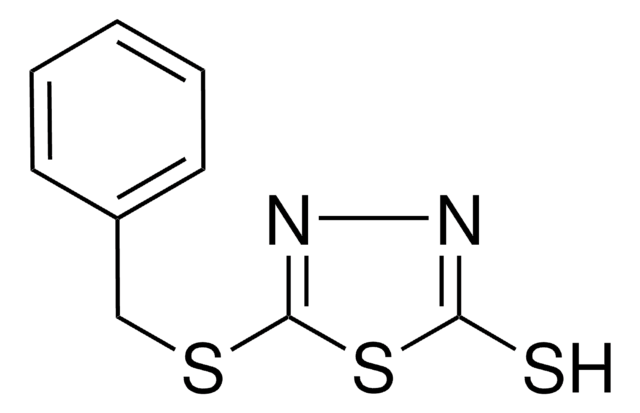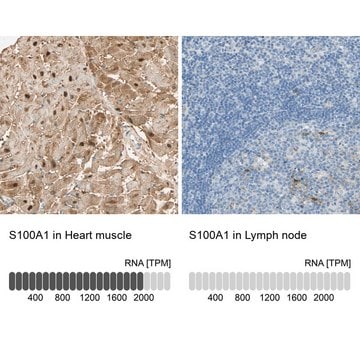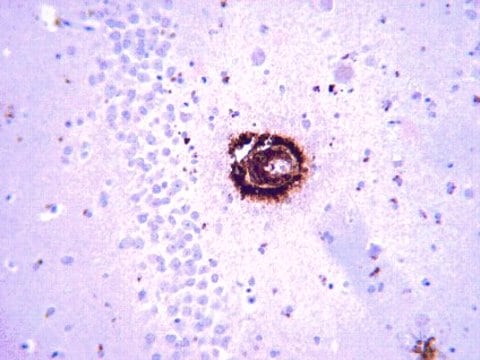MAB5740
Anti-Radial Glial Cell Marker-2 Antibody, clone RC2
clone RC2, from mouse
Sign Into View Organizational & Contract Pricing
All Photos(2)
About This Item
UNSPSC Code:
12352203
eCl@ss:
32160702
NACRES:
NA.41
Recommended Products
biological source
mouse
Quality Level
antibody form
purified antibody
antibody product type
primary antibodies
clone
RC2, monoclonal
species reactivity
mouse
technique(s)
immunohistochemistry: suitable
isotype
IgMλ
shipped in
wet ice
target post-translational modification
unmodified
General description
The monoclonal antibody Radial Glial Cell Marker-2, clone RC2 (RC2) was generated in mouse by conventional hybridoma methodology. The antigen recognized by RC2 is robust, allowing aldehyde fixation appropriate to high resolution light and electron microscopic analyses. From the neural tube stage of fetal development the antibody delineates throughout the central nervous system a subpopulation of neuroepithelial cells which have a radial bipolar morphology. RC2 also recognizes monopolar cell forms in the spinal cord and the cerebellum as early as E15, and in the dentate gyrus of the hippocampal formation from the day of birth. Monopolar forms in the cerebellum are inferred to be progenitors of Bergmann glia. The robustness of the antigen recognized by RC2 makes this probe a valuable tool to study the morphological transformations of the bipolar radial glia during their mitotic turnover. It also provides a sensitive stain for the study of the organization and the histogenetic role of the overall radial fiber system (3).
Specificity
Detects radial glial cell marker-2
Other species have not been tested.
Immunogen
Embryonic rat brain
Application
Anti-Radial Glial Cell Marker-2 Antibody, clone RC2 detects level of Radial Glial Cell Marker-2 & has been published & validated for use in IH.
Research Category
Neuroscience
Neuroscience
Research Sub Category
Neuronal & Glial Markers
Neuronal & Glial Markers
Physical form
Ammonium sulfate purified mouse monoclonal in PBS with 0.05% NaN3.
Format: Purified
Storage and Stability
Stable for 1 year at 2-8°C from date of receipt. Handling Recommendations: Upon receipt, and prior to removing the cap, centrifuge the vial and gently mix the solution.
Other Notes
Concentration: Please refer to the Certificate of Analysis for the lot-specific concentration.
Disclaimer
Unless otherwise stated in our catalog or other company documentation accompanying the product(s), our products are intended for research use only and are not to be used for any other purpose, which includes but is not limited to, unauthorized commercial uses, in vitro diagnostic uses, ex vivo or in vivo therapeutic uses or any type of consumption or application to humans or animals.
Not finding the right product?
Try our Product Selector Tool.
Storage Class Code
12 - Non Combustible Liquids
WGK
WGK 2
Flash Point(F)
Not applicable
Flash Point(C)
Not applicable
Certificates of Analysis (COA)
Search for Certificates of Analysis (COA) by entering the products Lot/Batch Number. Lot and Batch Numbers can be found on a product’s label following the words ‘Lot’ or ‘Batch’.
Already Own This Product?
Find documentation for the products that you have recently purchased in the Document Library.
Hitomi Aoki et al.
Development (Cambridge, England), 139(4), 667-677 (2012-01-14)
Rest (RE1-silencing transcription factor, also called Nrsf) is involved in the maintenance of the undifferentiated state of neuronal stem/progenitor cells in vitro by preventing precocious expression of neuronal genes. However, the function of Rest during neurogenesis in vivo remains to
Expression and immunolocalization of Gpnmb, a glioma-associated glycoprotein, in normal and inflamed central nervous systems of adult rats.
Huang, JJ; Ma, WJ; Yokoyama, S
Brain and Behavior null
Lei Wang et al.
Nature neuroscience, 19(7), 888-896 (2016-05-24)
The unique mental abilities of humans are rooted in the immensely expanded and folded neocortex, which reflects the expansion of neural progenitors, especially basal progenitors including basal radial glia (bRGs) and intermediate progenitor cells (IPCs). We found that constitutively active
Jan Mulder et al.
The European journal of neuroscience, 31(12), 2166-2177 (2010-06-10)
The Ca(2+)-binding proteins (CBPs) calbindin D28k, calretinin and parvalbumin are phenotypic markers of functionally diverse subclasses of neurons in the adult brain. The developmental dynamics of CBP expression are precisely timed: calbindin and calretinin are present in prospective cortical interneurons
Suyan Li et al.
The Journal of neuroscience : the official journal of the Society for Neuroscience, 33(37), 14809-14815 (2013-09-13)
Current models of brain development support the view that VEGF, a signaling protein secreted by neuronal cells, regulates angiogenesis and neuronal development. Here we demonstrate an autonomous and pivotal role for endothelial cell-derived VEGF that has far-reaching consequences for mouse
Our team of scientists has experience in all areas of research including Life Science, Material Science, Chemical Synthesis, Chromatography, Analytical and many others.
Contact Technical Service








